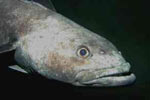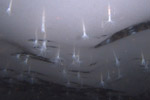
Patagonian toothfish, often sold as Chilean seabass. Photo by: U.S. FDA.
For the first time, marine conservation group, Sea Shepherd, is employing their controversial methods to protect Antarctic and Patagonian toothfish. Dubbed “Operation Icefish,” Sea Shepherd Australia is sending two ships into Antarctic waters to disrupt illegal vessels targeting the little-known species that are often sold in luxury markets as Chilean seabass.
“Our ships are once again preparing to take their place as the last line of defense to protect the precious marine life of Antarctica,” Peter Hammarstedt, captain of one of the ships said. “This year, we will track-down the criminal profiteers who poach vulnerable toothfish, we will drive them out of their hunting grounds in the shadowlands of the Southern Ocean, and we will deliver them into the hands of justice.”
For years Sea Shepherd has sent vessels into the Antarctic in attempts to disrupt whaling by Japan. But this year, Japan has stated it will only conduct non-lethal research in the area—after the The International Court of Justice (ICJ) ruled its whaling was in no way scientific—allowing Sea Shepherd to target a different threat, according to the group.
“Operation Icefish will be the first campaign of its kind, using innovative direct action tactics to fill a law enforcement void exploited by illegal toothfish operators,” Sea Shepherd Australia noted on its website.
Sea Shepherd has become famous for its aggressive direct action methods, including cutting nets, ramming docked vessels, boarding whalers, and throwing non-dangerous but smelly butyric acid at vessels. Such methods have set the group apart from most other environmental NGOs, such as Greenpeace, which practice only non-violent direct action.
 Little is known about the Antarctic toothfish, this one was captured and photographed underwater in McMurdo Sound, Antarctica. Photo by: Paul Cziko, supported by US-NSF through the DeVries-Cheng Lab at the University of Illinois, Urbana-Champaign. |
“When the poachers are found, their gear will be confiscated and the fish will be returned to the ocean. Sea Shepherd will also work with the relevant law enforcement agencies internationally to have these vessels arrested and impounded and the vessel owners held responsible for their operations,” said the captain of the second ship, Sid Chakravarty.
Patagonian toothfish (Dissostichus eleginoides) and Antarctic toothfish (Dissostichus mawsoni) are related species of cod icefish, in the family Nototheniida. Exploitation of the species, which started in the 1990s, is controlled by the Commission for the Conservation of Antarctic Marine Living Resources (CCAMLR). However, a number of illegal vessels operate in the high seas outside of national jurisdictions and far from any law enforcement.
The toothfish fishery remains controversial—even though in 2010 the Marine Stewardship Council put its sustainability stamp on a number of suppliers—given that scientists know very little about these species, including their total population and their role in the ecology of the region. Toothfish are some of the largest fish in the Southern Oceans, reaching up to 200 and 300 pounds, and, as such, are likely a big players in the health of the Antarctic oceans. The species also takes many years to mature, making fishing pressure potentially devastating.
“We actually know very little about the ecology of Antarctic toothfish,” David Ainley, a marine ecologist who conducts research in the Antarctic, told mongbay.com in 2011. “Because of the challenges of conducting science in the ice-choked Ross Sea, we know only vaguely where or when these fish spawn (sometime in winter, and maybe around the sea mounts well north of the Ross Sea), have no idea about natural mortality, a cursory idea of what predators eat them at the early stages, etc. We do know, though, that larger fish are important to sperm whales, killer whales and seals. The lack of insight about what is really going on is the most true for the Antarctic toothfish, which lives in a really harsh area making fishery science difficult at best, and in which all model inputs are ‘educated’ guesses, i.e. drawn from inputs for fish species elsewhere in other systems.”
Neither the Antarctic toothfish nor the Patagonian toothfish have been evaluated by the IUCN Red List.
The new campaign by Sea Shepherd is especially notable for targeting two non-charismatic, little-known species—even if they are offered at restaurants and luxury markets worldwide. However, the campaign may not last long. Japan has stated it plans to begin whaling again in 2015, albeit for a smaller number of whales. If that’s they do, it’s likely Sea Shepherd will again focus their efforts on whales.
Related articles
Genetic sleuthing reveals grisly details of historic whale hunting
.150.jpg)
(11/05/2014) In 1904, Carl Anton Larsen, a Norwegian Antarctic explorer, arrived at Grytviken on the British island of South Georgia with three ships and 60 men, to establish its first commercial whaling station. The number of whaling stations soon increased, and by 1965 these had caught and processed an estimated 175,250 whales.
Russia and China blamed for blocking Antarctic marine reserve

(11/03/2014) Another year, another failed attempt to protect a significant chunk of the Ross Sea, which sits off the coast of Antarctica. According to observers, efforts to create the world’s biggest marine protected area to date were shot down by Russia and China during a meeting in Hobart, Tasmania of the Commission for the Conservation of Antarctic Marine Living Resources (CCAMLR).
Japan changes its mind about Antarctic whaling ban, plans to continue hunts in 2015

(04/25/2014) Conservation groups were jubilant in response to last month’s ruling by the International Court of Justice (ICJ) banning Japan’s long-standing “research” whaling practices in the Antarctic. However, the celebrations proved short-lived after news last week that Japan has rescinded its agreement to abide by the ruling and stop whaling altogether, opting instead to redesign its program and continue whale hunts in the Southern Ocean.
Court partially stops Japan’s ‘scientific’ whaling, but Pacific harvests to continue

(04/01/2014) Japan has harvested thousands of whales in North Pacific and Antarctic waters since the implementation of a global ban on whaling, eliciting harsh criticism from the international community. Now, in a landmark decision, the International Court of Justice (ICJ) has ruled that Japan must cease its whaling activities in the Antarctic.

(03/13/2014) Human-caused climate change is altering the habitat of Adélie penguins (Pygoscelis adeliae). In an article recently published in PLOS ONE, a team of researchers led by Amélie Lescroël from the Centre d’Ecologie Fonctionnelle et Evolutive (CNRS) in France, found that changes in sea-ice content and newly formed icebergs significantly impacted Adélie penguin communities in the Ross Sea.
Amazing discovery in Antarctica: sea anemones found living upside down under ice (photos)

(01/27/2014) Sea anemones are supposed to sit on the bottom of the ocean, using their basal disc (or adhesive foot) to rest on a coral reef orsand. So, imagine the surprise of geologists in Antarctica when they discovered a mass of sea anemones hanging upside from the underside of the Ross Ice Shelf like a village of wispy ghosts. The researchers weren’t even there to discover new life, but to learn about south pole currents through the Antarctic Geological Drilling (ANDRILL) Program via a remotely-operated undersea robot.
Global warming could upset Antarctic food chain

(01/02/2014) Resting near the bottom of the foodchain, Antarctic krill (Euphausia superba) underpin much of the Southern Ocean’s ecosystem. But in a rapidly warming world, these hugely-abundant crustaceans could see their habitat shrink considerably. In a recent paper in PLOS ONE, scientists predict that Antarctic krill could lose 20 percent of their growth habitat, or 1.2 million square kilometers.